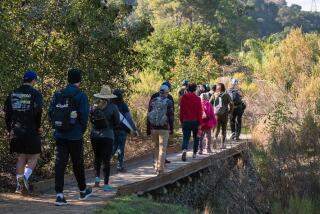Committee Scraps Cuts in Conservancy Budget
- Share via
SACRAMENTO — Dire predictions of park closures and staff cutbacks gave way to ambitious plans for the purchase of parkland and open space Tuesday after legislative budget writers restored money they had slashed from the Santa Monica Mountains Conservancy budget last week.
“We got everything that we really wanted,” said Joseph Edmiston, executive director of the conservancy, a state agency that buys land in the Santa Monica Mountains and the San Fernando Valley foothills. “We made a major breakthrough in terms of having the members of the committee understand the kind of public support” for the conservancy.
Edmiston’s upbeat assessment of how the agency fared in a two-house budget conference committee was in sharp contrast to expressions of gloom and doom heard last week after budget writers eliminated $253,000 in state funding from the conservancy’s operating budget.
After an intensive lobbying campaign by the conservancy and its legislative allies, lawmakers who had been skeptical of the need to support the agency when the state is in tough fiscal times did an about-face late Monday and agreed to provide $100,000 for operating expenses.
The remainder will come from a temporary loan of money from Proposition 70, the massive $776-million park bond measure passed by California voters June 7.
‘Pretty Deep’
Assemblyman John Vasconcellos (D-Santa Clara), chairman of the conference committee and a critic of the conservancy, conceded that the original budget cut--which eliminated all state general fund support for the agency--was “pretty deep.”
The use of a combination of state money and bond funds to run the agency is “the cheapest way to get away with it,” Vasconcellos said.
Assemblyman Terry B. Friedman (D-Tarzana) hailed the decision to restore funding for the agency. “The action of the conference committee was a complete victory for the maintenance of the conservancy program,” he said.
Conservancy officials warned last week that without state support, parks would be closed, staff members would be laid off and Proposition 70 bond funds earmarked for land purchases could not be spent.
The bond measure provided $30 million for acquisition of parkland in the Santa Monica Mountains and another $10 million for purchases in the San Fernando Valley foothills.
The budget conference committee agreed to let the conservancy go ahead with priority land purchases subject to a 30-day review period by the Legislature.
“It will allow us to move ahead on a program to try to protect it from development before it is lost for open space and recreational use in the future,” Friedman said.
Both Friedman and Edmiston credited Assemblywoman Maxine Waters (D-Los Angeles), a member of the budget writing committee, for turning around the conservancy’s budget fortunes.
Waters added to the conservancy’s capital budget a project to refurbish buildings at Hunter Ranch in the Malibu Creek State Park.
27 Projects
The conservancy’s priority list contains 27 projects totaling about 11,100 acres that it wants to buy in the Santa Monica Mountains.
The list includes 1,900 acres in the Rustic and Sullivan Canyon area on the eastern edge of Topanga State Park, south of Mulholland Drive, and another 400 acres in Mission Canyon, a former landfill, just west of the San Diego Freeway.
Another 2,300 acres of oak-studded canyon and rolling grassland is slated for acquisition in Palo Comado Canyon, north of the Ventura Freeway and west of Cheeseboro Canyon in Agoura Hills.
Along the rim of the San Fernando Valley, the conservancy has another nine projects totaling 4,220 acres on its priority list.
The largest is 2,300 acres in the Sunshine/Bee Canyon area of the Santa Susana Mountains, north of Granada Hills and adjacent to O’Melveny Park.
The conservancy also wants to buy 500 acres in the Santa Susana Mountains and Simi Hills wildlife corridor along the Los Angeles-Ventura county line and another 400 acres at Sage Ranch, southeast of the City of Simi Valley.
The conservancy has purchased 9,800 acres during its nine-year existence.
More to Read
Sign up for Essential California
The most important California stories and recommendations in your inbox every morning.
You may occasionally receive promotional content from the Los Angeles Times.










